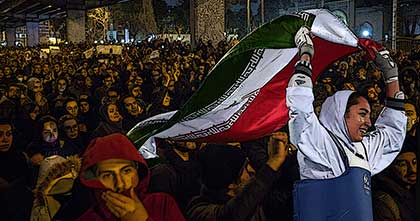Nathan Gardels is the editor-in-chief of Noema Magazine.
When a seminal event spectacularly reveals official lies, public trust that has been eroding in a system that for so long has denied obvious truths finally snaps. The flood gates open and all the bottled-up or repressed disaffection pours out in waves of anger, disdain and contempt. The last ounce of legitimacy drains away. It is the beginning of the end for the ruling regime that was able to eke out survival long past its due date.
This is what happened in the Soviet Union after the Chernobyl nuclear catastrophe in 1986. It is what may be happening today in Iran with the belated admission by the authorities that it was the very Islamic Revolutionary Guard Corps, which has staked its power and prestige on protecting the nation from outside threats, that mistakenly shot down a Ukrainian airliner just after it left the airport in Tehran, killing all 176 people on board.
As a member of the council of advisors to Mikhail Gorbachev’s post-Cold War organization, Green Cross International, I had the opportunity on several occasions to discuss with him the causes of the unravelling of the Soviet system.
For Gorbachev, Chernobyl was more than an accident: it was the beginning of the meltdown of the Soviet Union itself, a “historic turning point” and “perhaps the main cause of the collapse of the Soviet Union five years later.” As Yevgeny Velikhov, the nuclear scientist who headed the emergency response team also told me, the secretive cover-up culture of the Soviet state kept timely information from getting to the top so a quick response could be formulated. The dire consequences of this penchant to hide the facts, not only from the people but also the leadership, exposed the imperative of greater freedom of expression. It “made starkly apparent how important it was to continue the policy of glasnost,” Gorbachev recalled. Yet, as Gorbachev did not fully anticipate, when the lies were taken away, there was nothing there. The emperor had no clothes.
In Iran, already tightly squeezed by American sanctions, public outrage at the incompetence and dissimulation of the authorities over the downing of the airline has exploded in a revival of widespread demonstrations that broke out, and were harshly repressed, last November. The national pride that fueled the huge rallies last week commemorating the assassination of the IRGC leader, Qasem Soleimani, by the U.S., turned overnight against the government. Protestors chanted “shame on you, guards, leave the country alone” and “we don’t want the Islamic Republic.”
Even key figures in the mainstream media that long carried water for the regime can no longer bear their own collusion. In an Instagram post, the popular host of a state TV channel wrote: “It was very hard for me to believe the murdering of my countrymen. Forgive me for believing it too late. I apologize for lying to you on TV for the last 13 years.”
As we’ve seen in other cases of upheaval, systemic opposition deepens when figures from popular culture converge in the same stream of revolt. This week, Iran’s sole female Olympic medalist, Kimia Alizadeh, announced her defection from the Islamic Republic. “I am one of the millions of oppressed women in Iran whom they have been playing for years,” she wrote on Instagram. “They put my medals on the obligatory veil and attributed it to their management and tact.” Dripping with derision, she said she “didn’t want to sit at the table of hypocrisy, lies, injustice and flattery” or any longer participate in the regime’s “corruption and lies.”
The parallel here is obvious to the long drip of defections over decades by cultural icons in the Soviet Union, from the ballet star Rudolf Nureyev to the cellist Mstislav Rostropovich.
Analogies, of course, only go so far. Iran is a far more democratic system than the Soviet Union ever was, with regular elections, however manipulated and constrained. And large public protest movements, though ultimately repressed, have emerged over recent years, including the Green Movement for reform after the presidential election in 2009. Even if not totally free, the more space there is for public expression, the less brittle and more amenable a system is to evolutionary change.
Yet, if the public outrage this week in Iran is any indication, the interval of five years from Chernobyl to the collapse of the Soviet Union does not seem a far-fetched timeframe for the demise of the regime of the ayatollahs that is now 41 years old.




